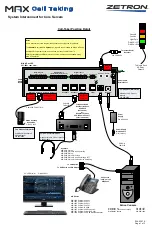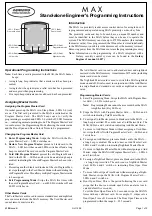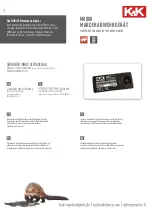
Wall Controller WALLC-
S
2
Quick Start
This remote control has two modes:
•
Normal operation
for daily use
•
Management mode
for setup
Pushing all four buttons for 1 sec. turns the device into management mode
(indicated by slow blinking green LED). Management mode time-out is 10 sec. In
factory default mode pushing one of the four buttons for 1 sec will start different
inclusion modes:
•
Button 1: Include (add) Wall Controller as secondary controller
•
Button 2: Include (add) Wall Controller as secondary controller – non secure
•
Button 3: Include (add) new device into Wall Controller network
•
Button 4: Include (add) new device into Wall Controller network – non secure
The processes for button 1 and 2 is indicated with fast red/green blinking, the
processes for button 3 and 4 shows a fast green blinking. Every button push stops
the process. This fast inclusion
only works when device is in factory default
.
Once one device is included or the Wall Controller is included as secondary
controller further inclusion and exclusion operation require to turn the device into
management mode:
•
Button 1: Include or exclude the device as secondary controller
•
Button 2: Issue Wake Up Notification and send out Node Information Frame
•
Button 3 followed by short click on button 1: Start secure inclusion
•
Button 3 followed by short click on button 2: Start unsecure inclusion
•
Button 3 followed by short click on button 3: Start exclusion
•
Button 3 followed by short click on button 4: Start primary handover
Attention:
For convenience reasons some special short cut apply IF and only and
only
IF the Wall Controller is the primary controller of the network. The first
device included into a button group will define the commands sent
out by this
group regardless of the default value of the configuration parameters 11-14. If the
device is a door lock the button group will turn into door lock control (value=7). For
dimmers and motor controls the value changes into Multilevel Switch Control
(value=1). All other devices will turn the button group into Basic Control (value=2).
All configuration values can be changed if needed. When the Wall Controller is
primary controller the
very first device included
will be
automatically put into
button group A
and the command set will change according to the rules just
mentioned. All other devices need to be put in button groups manually.
Product Description
The wireless Wall Controller is a 4
button Z-Wave device capable to act
both as primary or secondary
controller. The four
buttons can
control other Z-Wave devices
such
as switches, dimmer and even door
locks directly. Various options –
configurable by Z-Wave configuration
commands – define the actions and the
commands used for this control. It is
possible to use two sets of buttons
(one for on/open/up and one for
off/closed/down) or four single buttons
to control four different groups of
devices.
The controller also allows
triggering scenes in a central controller
. Again different
modes can be configured to adapt to the various implementations of scenes in
different central controllers in the market. Control options also include special modes
like „all on/off“ or always controlling the Z-Wave device in proximity to the controller.
The
device supports secure communication
when included with enhanced
security option and when communicating to a device also supporting enhanced
security option. Otherwise the device will automatically turn into normal
communication to maintain backward compatibility.
Installation Guidelines
The device comes ready to use with a battery already installed. Just pull the plastic
strip to activate the device. The device can be mounted on every dry and flat surface
using either screws or double side adhesive. First the mounting base is fixed on the
wall. Next step the switch frame is placed on the 2 frame and the electronic insert is
used to fi x the frame to the mounting base as shown on the image. Finally the
switching paddle(s) are mounted on the electronic base.
For battery change, the switching paddle(s) need to be removed. The CR battery
can be replaced by pushing the little nipple above the battery. The old battery will
slide out and the new battery is inserted until the nipple will hold it again.
The device can be operated in two different modes:
•
Operation mode:
This is the mode where the device is controlling other
devices.
•
Management Mode:
The device is turned into the management mode by
pushing all four buttons for one second. A blinking LED indicates the
management mode. In the management mode buttons of the device have
different functions. If no further action is performed the device will turn back to
the normal mode after 10 seconds. Any management action terminates the
management mode as well.
In management mode the following actions can be performed:
•
Button 1
– Inclusion/Exclusion: Every inclusion or exclusion attempt is
confirmed by hitting this button. Single click is used for standard inclusion and
exclusion, double click is used for network wide inclusion. With this operation
the device can be included into a Z-Wave network from any physical location in
the network. This requires a primary controller supporting network wide
inclusion. This mode lasts for 20 seconds and stops automatically. Any button
press stops the mode as well.
•
Button 2:
Sends Node Information Frame and Wake Up Notification (see
explanation below).
•
Button 3:
Activates the primary controller management menu. The following
sub menu items are available:
Button 3 followed by short click on button 1:
Start Secure Inclusion
(Add)
Button 3 followed by short click on button 2: Start Unsecure Inclusion
(Add)
Button 3 followed by short click on button 3: Start Exclusion
(Remove)
Button 3 followed by short click on button 4: Start Primary Handover
Button 3 followed by pushing button 4 for 5 seconds: Factory Default
Reset.
After clicking on button 3 keep button 4 pushed for 4 seconds.
•
Button 4:
Enters into association mode to assign target devices to one of the
four associations. Refer to the manual‘s section about association for more
information how to set and unset association groups.
In factory default mode pushing one of the four buttons for 1 second will start
different inclusion modes:
•
Button 1: Include Wall Controller as secondary controller
•
Button 2: Include Wall Controller as secondary controller – non secure
•
Button 3: Include new device into Wall Controller network
•
Button 4: Include new device into Wall Controller network – non secure
The process for button 1 and 2 is indicated with fast red/green blinking, the process
for button 3 and 4 shows a fast green blinking. Every button push stops the process.
This fast inclusion only works when device is in factory default.
Attention:
For convenience reasons some special short cut apply IF and
only IF the
Wall Controller is the primary controller of the network: The first device included
into a button group will define the commands sent
out by this group regardless of
the default value of the configuration parameters 11-14. If the device is a door lock
the button group will turn into door lock control (value=7). For dimmers and motor
ZME WallC-
S
2
1
Содержание ZME WallC-S2
Страница 5: ......






















